HARRY ROSELAND:
THE ARTIST AND THE FORTUNE TELLER
How did the Mammy come to be known as a fortune teller? Well, that is an interesting tale. There were and
always have been African American card readers, tea laf readers, crystal ball readers, clairvoyants, spirit mediums,
palm readers, and root doctors. But they were not generally portrayed as Mammies.
The fusion of the Mammy and the Fortune teller was the accidental byproduct of the artistry of one
man, Harry Roseland (1868-1950), a genre painter who portrayed an elderly fortune teller in Brooklyn who happened
to read for folks out of her home -- that is, in her living room and in her kitchen, in front of her fireplaces.
The images of the professional reader in her parlour were discarded in time,
but the images of her reading for clients and mixing up
rootwork remedies in her
kitchen became fused with the kitchen-bound Mammy in the popular mind,
and led to the visual trope of the Mammy-as-reader.
Because Roseland photographed his subjects as reference for his oil paintings,
we can see how he posed his subjects, moved props in and out of the
frame, and, in some cases, composited portions of one photo with another, much
as a modern artist would now use a graphic editing system like Photoshop.
I have listed elements used in the pictures. In some cases they help us date the
paintings or the give us clues into the sequence or number of photo shoots. Do not let
details such as hair-colour or dress-colour distract you from seeing the black-and-white
photos from which these paintings were derived.
Tea Leaf Reading: Paintings by Harry Roseland
This series of paintings arises from a single photo-shoot at which the fortune teller,
reading tea leaves, is attending upon three young Caucasian female clients. The date of the photo-shoot is
unknown, but the clothing styles seem to indicate
a time period of 1890 - 1899.
We begin with the female African American fortune teller and the full complement
of the three young female Caucasian models who attended the photo-shoot from
which this group of paintings developed. I have assumed, as have others, that
at least two of these young women were Roseland's daughters; he used them as models in
other paintings as well.

The Love Drop by Harry Roseland
(Postcard Version; 3 3/4" X 5 1/2", Copyright 1906, American Journal Examiner;
back of card reads "Compliments of Kelley and [xxx] Sunday American)
Elements:
Three Clients,
Straw Hats,
Parasols,
Knitting Equipment in Hat Box,
Loose Yarn Balls,
Cup and Saucer,
Kitten,
Table with Cloth,
Three-Rung-Straight-Back Chair,
Rocking Chair,
White Crocheted Shawl,
Cauldron over Fire,
Arched Fireplace,
Rag Rug
"The love drop" is a tea leaf reader's term of art referring to the last
drop that falls from the cup
as it is swirled and prepared for image-reading. The love drop is always
dripped into the saucer, which we see here below, on the floor, and, unlike the rest of the
tea leaves, which may symbolize diverse life situations, it provides a
special glimpse into love affairs only. Its use may derive from the
traditions of Irish tea leaf readers, who tend to read the leaves in the saucer, not in the
cup.
Next, one woman is eliminated from the photo-shoot. We now see the female African American fortune teller
with two young female Caucasian models. These are the women i am calling his daughters. One has a hat that
is upswept in the back. There is ruching on her sleeves and her skirt is tiered. The other has a flatter hat,
with a simpler crown, and her skirt is not tiered. Both women have parasols.

Reading Tea Leaves by Harry Roseland
(Large Print Version; 1910)
Elements:
Two Clients,
Straw Hats,
Parasols,
Knitting Equipment in Hat Box,
Loose Yarn Balls,
Cup and Saucer,
Brown Tea Pot,
No-Kitten,
Table with Cloth,
Three-Rung-Straight-Back Chair,
Rocking Chair,
White Crocheted Shawl,
Rectangular Fireplace,
Rag Rug
The third series of tea leaf reading paintings features the female African American fortune teller
with one young female Caucasian model.

The Fortune Teller a.k.a. Reading Tea Leaves by Harry Roseland
(Large Print Version; Undated)
Elements:
One Client,
Straw Hat,
Parasol,
Knitting Equipment in Hat Box,
Loose Yarn Balls,
Cup and Saucer,
Brown Tea Pot,
Kitten,
Two-Rung-Straight-Back Chair,
Rocking Chair,
White Crocheted Shawl,
Arched Fireplace,
Rag Rug

The Fortune Teller by Harry Roseland
(Post Card Version; Undated)
Elements:
One Client,
Straw Hat,
Parasol,
Knitting Equipment in Hat Box,
Loose Yarn Balls,
Cup and Saucer,
Brown Tea Pot,
No-Kitten,
Two-Rung-Straight-Back Chair,
Rocking Chair,
White Crocheted Shawl,
Rectangular Fireplace,
Rag Rug

Seeing into the Future
(Undated; Large Print Version)
Elements:
One client, Cup, No-Kitten, Rectangular Fireplace, Bellows
The fourth series of tea-leaf reading paintings that derives from this photo-shoot moves in for closeups of
the model with the up-turned hat, now at a table, and we also see a brown tea pot and a leather
knife case.

The Oracle by Harry Roseland
(Undated, circa 1899)
Elements:
One Client, Brown Tea Pot, Tea Pot, Knife-Case, Yarn Balls, Cauldron over Fire, Arched Fireplace,
Crooked Picture
In December 2013 at the Ebay auction site, a large scrapbook album
page was offered for sale on which was pasted down a 12" x 9" sheet
apparently cut from a slick-paper magazine or book on art, containing a black-and-white
reproduction of this painting. Under the image is the following
legend: "The Oracle by Harry Roseland. This is a reproduction of an oil
painting typical of the modern American school both in subject and treatment."
Reproduction of his work in an educational venue
of this type indicates the respect and honour accorded to
Roseland at this point in his career; as a member of "the modern American school,"
who created "oil paintings," he was being presented to the public as a fine or gallery artist
who kindly allowed his images to
be reproduced for commercial purposes, rather than as a commercial artst who
just happened to be a good painter.
The problem with being a gallery painter who had a side-career as a commercial
artist is evident in a comparison of this black-and-white reproduction of what
was obviously a full-colour oil painting with the next image below. The second
version (title unknown, but i shall call it "The Oracle II" until i find a titled version
of it) is a copy of the first one.
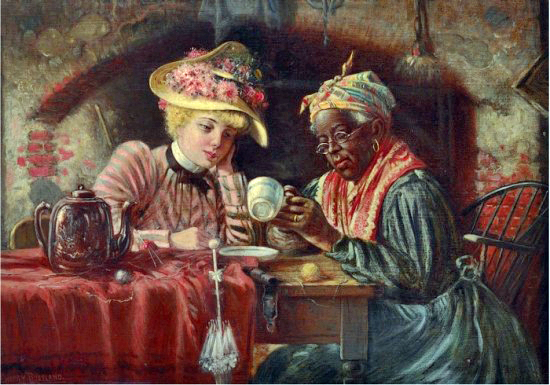
The Oracle II by Harry Roseland
(Undated, after 1899)
Elements:
One Client, Brown Tea Pot, Tea Pot, Knife-Case, Yarn Balls, Arched Fireplace, Crooked Picture
Roseland repainted "The Oracle" (see the entry immediately above) in order to
sell reproduction rights to a calendar, postcard, or print-making company. The
copy was probably made after 1899. The most notable differences on immediate
viewing are the change in the fortune teller's chair, the addition of a striped
edging to the table cloth, and the deletion of the fireplace tongs at
right, to compensate for the higher chair-back in the second version.
I assign this version as the copy rather than the original due to a number of
factors.
First, there is the blurring out of details on the cast iron cauldron, feather
whisk, and parasol, which, to me, are indications of more hurried work and also
passing time: The fireplace tongs and cauldron were obsolete kitchen utensils and the parasol
was an obsolete article of clothing after 1910.
Second, the addition of a striped edge to
the table cloth also places this in a later group of images, for none of the earlier ones
feature this detail. In fact, what we are calling a table cloth may have
been a simple piece of sheeting or a rag used for modelling purposes at the original photo-shoot,
which was only gradually developed into a formal table cloth in later renditions.
Third, this painting falls into the group in which an
attractive slate-blue colour-palette is introduced, possibly to take advantage
of the cyan plate in four-colour lithography. This colour-range is not evident in
any of the older paintings, and i believe it was intentionally developed for
Roseland's commercial publishing clients.
The copy is undated, but i do not believe it to be a late copy,
because in the latter, the specificity of the fortune teller's face, as well as the faces of her
clients, becomes lost, and the women begin to vary in age and phenotype,
in keeping with changing social memes and the needs of commercial clients. Additionally,
in later paintings, Roseland uses a flatter, broader brush stroke, and begins to work
in what can best be described as a nascent Art Deco style, with a new emphasis on
the pastel colour pallette so popular in that era.

The Tea Cup's Fortune-Telling by Harry Roseland
(1906, dated and signed at middle right; this is a postcard version of the painting)
Elements:
One Client, Red Tablecloth, Brown Tea Pot, Parasol, Knife-Case, Yarn Balls; Candle Stick, Crooked Picture
Here we return to a more naturalistic rendition of the original photo shoot. The close-up
composition works well in the horizontal postcard format. The tablecloth
is unstriped, the parasol is distinctly rendered, and other elements are precise in detail.
A comparison of this painting with the two immediately above makes it obvious that this picture
was modelled after photos taken at the same sitting as The Oracle and the copy that
i am calling The Oracle II.

Reading Tea Leaves
(Undated)
Elements: One Client, Striped Table Cloth, Bellows, Chairs
I have never seen this painting as a print; the coarseness of the brush-strokes and lack of detail
would seem to indicate that it was a quickly rendered
miniature oil-paint study for a larger work which was never realized. However,
compare it with the finished painting titled "Reading Her Cards" from the card reading series. Both were
obviously posed and photographed at the same session.
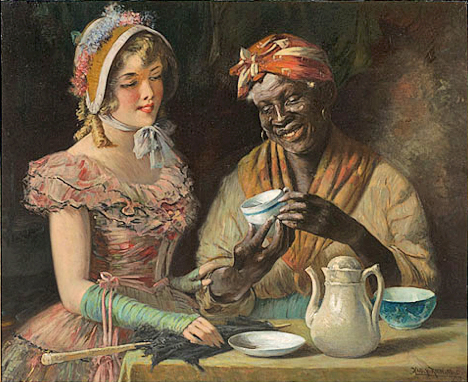
The Cup Reader
(Undated, circa 1920s)
Elements: One Client, Table Cloth, Blue and Cream Porcelain
During the 1920s, America experienced a fashion-fad of nostaligia for the
Colonial and Early Victorian periods. This painting uses elements from
Roseland's original tea-leaf photo-shoot but replaces the original Late Victorian clothing
and simple brown tea pot with then-nostalgic Early Victorian costume and fancy blue-patterned china-ware.
The flatter pastel-colour pallette also mark this as
a work of the 1920s.
Costume details aside, the most important differences between this late painting and
the naturalistic ones of twenty to twenty-five years earlier is
the smile on the reader's face. Roseland was making the reader appear "cheerful and loving"
in keeping with changing tropes of the period, in which the public was increasingly presented with
nostalgic images of "Happy Negro Slaves" who had functioned in a fictionally value-neutral ante-bellum South.
Thus the naturalistic depictions of a real-life elderly African American fortune teller who lived in Brooklyn, New York,
circa 1890 - 1915 are recast as images of the generic Loving Mammy of Dixieland.
If you look more closely at this image, you will also notice
the client's intimate and child-like petting of the Mammy's wrist. This is an obvious gestural
signal to the viewer that the two women know and love one another and that the older woman
was once the younger's care-taker. We are no longer being shown glimpses into the
professional practice of an independent black American fortune teller or spiritual root doctor
who is consulted by adult white female clients; rather what we see is an intimate and happy domestic
moment shared between a household slave or servant and the young girl who grew up
under her care and is now embarking on expectant adulthood. The Mammy in the kitchen
who performs the function of a diviner for the child she raised does so in a
loving, maternal manner, and only brings good tidings to the girl.
The serious and occasionally stern-faced fortune telling woman of the
1890s was one of several figures whom Roseland presented to his white
gallery-art clients as documentary evidence of the struggle for full social and financial
equality engaged by post-Emancipation black
Americans in the era following upon the desperate financial panic and
depression of 1893 - 1897. In a future article, currently in preparation,
i will examine other images of this type
and seek to place the fortune teller series within the broader context of
Roseland's anti-apartheid political agenda.
Beginning in 1898, as a 30-year-old genre artist, Roseland had carefully depicted the
fortune teller as an independent agent, albeit a member of the
economic lower classes. The fortune teller broke social norms and
conventions of the period by inviting adult white women into her home,
where she divined their futures on her front parlour sofa or prepared
hoodoo
remedies for them in her kitchen. However, by the 1920s, his presentation
of the same woman was that of a pleasing domestic servant who lived a life of
economic dependency in the kitchen of a white family. Her valuable ability to
read for clients had been reduced to a trivial and curious expression of Negro
superstition, with which she affectonately entertained the Little Miss
of the household.
We may well wonder if this significant change in the implicit programmatic values
conveyed by Harry Roseland's fortune teller images -- in particular, the sharp
shift from an elderly woman's indominable claim on independence, empowerment, and equality
during a time of widespread economic disarray to
a comfortable acceptance of second-class citizenship during a time of rising social
inequality and Jim Crow laws -- does not indicate an erosion or effacement of the
artist's earlier social values. In my opinion, and i say this in the absence of any written
record of Harry Roseland's attitudes toward his subjects, i think that what the
shifted images show us are, sadly, not a loss of political values, but
rather an aging commercial artist's financial need to meet the
changing requirements of his commercial art clients. By drawing upon
his old photo-shoot to repackage an extremely popular series of images, Roseland was able
to keep his career going, even though his work had finally made the slip
from documentary genre paining of "the modern American school" to full-tilt commercial art,
in which both realism and the artist's vision of the world must be subsummed to
the art-client's mercantile goals of pleasing and amusing the buyer of the
product to which the image is affixed.
Card Reading: Paintings by Harry Roseland
I have collected a series of 14 paintings in which the black fortune teller is reading cards.
The cards are a pack of ordinary playing cards, and the
layout the reader uses seems most often to be three rows of five, a popular 19th century spread called The Fifteen
Card Method.
It is obvious that this series was difficult for Harry Roseland to compose, due to the small size
of the cards and their indistinct markings. Perhaps the most beautiful image is the
1898 paining "It's All in the Cards," in which
the cards are seen very clearly against the black leather of the sofa, but this composition
might be judged unsuccessful to the popular eye because the reader's back is turned to the viewer.
In 1899, a different painting from the same photo-shoot was released, titled "Reading the Cards,"
but although in this painting we can see the reader's face, it in the first in which the ungainly
devise of the hat box lid was introduced as a reading surface. No real card reader would ever
use a small, light-weight circular surface to read by the Fifteen Card Method, and all subsequent images in
which the hat box lid appears are lacking in the naturalism for which Roseland was justly
celebrated. Only a card-reader might pick up on the awkwardness, of course -- and to the public,
these hat-box-lid scenes probably look just fine.
In his repeated attempts to capture the essence of the
card readings, Roseland posed his subjects in a wide variety of seating arrangements, moving from
the sofa to a table. The table was -- and remains -- the standard
surface for card reading, but the angle was too tall for Roseland to clearly show the faces of
the cards. He can only show the reader holding a card, never the full layout.
At this point he left the world of naturalism and began setting up paired chairs with a
variety of stools between them on which a flat surface was laid for the card reading. In some cases he
resorted to the awkward device of a lap-board.
The lid of the reader's hatbox, in which she keeps her knitting, provides an incredibly fragile and
awkward reading surface; better is the wooden checkerboard. The latter may look like a random square of
wood to a viewer unfamiliar with the other paintings Harry Roseland made of this family, but there
are several in which the reader's husband and grandchildren play checkers on this same board.
Finally, as a last resort, he places the reader on the floor, in imitation of European "Gypsy card reading"
paintings of his era. While the compsition is satisfactory, the reader must now employ the typical
Gypsy arc-of-cards layout, whch was pretty obviously not this woman's chosen method. Not only that,
seeing the reader, obviously an elderly lady with mobility issues, seated on the floor is a bit
odd: you just know she would never have done that herself, and you can only imaging how her bones
ached after taking that pose!
As with all of Harry Roseland's other paintings, titles were often re-used, especially when the images
were to be printed in sets of six postcards, so i have given each image a unique descriptor.
I have organized them roughly by location within the home, number of clients, and then chronologically.
Sofa
1 Harry-Roseland-It-s-All-In-The-Cards-1898-Sofa-Chair-One-Client.jpg
2 Harry-Roseland-Reading-The-Cards-1899-Hat-Box-Lid-Lap-Sofa-One-Client.jpg
3 Harry-Roseland-The-Fortune-Teller-1910-Card-Reading-Hat-Box-Lid-Lap-Sofa-One-Client.jpg
4 Harry-Roseland-The-Fortune-Teller-Undated-Card-Reading-Hat-Box-Lid-Lap-Sofa-Chair-Two-Clients.jpg
Table and Chairs
5 Harry-Roseland-Pick-A-Card-Undated-Red-Tablecloth-Chairs-Two-Clients.jpg
6 Harry-Roseland-Reading-Her-Cards-Undated-Banded-Tablecloth-Chairs-One-Client.jpg
Chairs and Stools
7 Harry-Roseland-Reading-The-Cards-Undated-Four-Legged-Stool-Chairs-Two-Clients.jpg
8 Harry-Roseland-The-Prophesy-Of-The-Cards-1923-Checker-Board-Four-Legged-Stool-Chairs-One-Client.jpg
9 Harry-Roseland-Reading-The-Cards-1903-Checker-Board-Lap-Chairs-Two-Clients.jpg
10 Harry-Roseland-The-Fortune-Teller-1903-Card-Reading-Checker-Board-Hat-Box-Kitchen-Stool-Chair-One-Client.jpg
11 Harry-Roseland-The-Fortune-Teller-1908-Card-Reading-Hat-Box-Kitchen-Stool-Chairs-One-Client.jpg
12 Harry-Roseland-The-Fortune-Teller-Undated-Card-Reading-Hat-Box-Footstool-Chairs-One-Client.jpg
13 Harry-Roseland-The-Fortune-Teller-Undated-Card-Reading-Hat-Box-Lid-Lap-Chairs-One-Client.jpg
Floor
14 Harry-Roseland-The-Fortune-Teller-1904-Card-Reading-Floor-And-Chair-One-Client.jpg
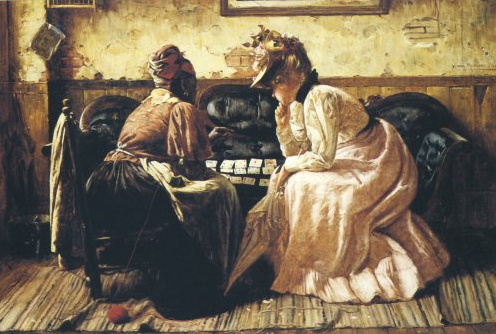
It's All in the Cards
(1898)
Elements:
One Client, Sofa,
Rag Rug,
Playing Cards,
Hat Box

Reading the Cards
(1899)
Elements:
Sofa,
One Client,
Playing Cards,
Rag Rug,
Hat Box,

The Fortune Teller
(1910; signed, oil on canvas, 20" x 30")
Elements:
Playing Cards,
Sofa,
One Client,
Footstool,
Hat Box,
Rag Rug,
Purse

The Fortune Teller
(Undated)
Elements:
Sofa,
Playing Cards,
Rag Rug,
Two Clients

Pick A Card
(Undated)
Elements:
Table,
Red Tablecloth,
Brown Teapot,
Chairs,
Rag Rug,
Workbasket,
Yarn Balls,
Two Clients

Reading Her Cards
(Undated)
Elements:
Table,
Striped Tablecloth,
Chairs,
Rag Rug,
One Client

Reading the Cards (1903; Square Lap Board, Two Women)

The Fortune Teller (1903, square checker or Chess Board on Hat Box)

The Fortune Teller
(1908, Unsigned; 11 1/2" x 11 1/2"; this was a calendar print
for McCormick farm implements, hence the square format;
see a fuller version of the calendar above)
Elements:
Playing Cards,
Hat Box,
One Client,
Kitchen Stool

The Fortune Teller
(Undated)
Elements:
Playing Cards,
Lap,
Hatbox Lid,
Chairs,
One Client

The Fortune Teller
(Undated)
Elements:
Playing Cards,
Hat-Box,
Footstool,
Chairs,
Work Basket,
Loose Balls of Yarn,
One Client

Reading the Cards
(Undated, Oil on Canvas; 20" x 32", Signed Upper Middle Right)
Elements:
Playing Cards,
Four-Legged Stool,
Chairs,
Bellows,
Braided Rug,
Two Clients

The Prophesy of the Cards
(1923)
Elements:
Playing Cards,
Checkerboard,
Four-Legged Stool,
Chairs,
Two Clients

The Fortune Teller
(1904)
Elements:
Playing Cards,
Floor,
One Client
Crystal Gazing: Paintings by Harry Roseland
I have found 2 paintings in which the black fortune teller is reading a crystal ball,
but there is a third painting which is attributed online to "Luca Sacco, after Harry Roseland,"
which i have included here and described below.

Crystal Ball (Undated)
Elements:
Crystal Ball,
Floor,
One Client,
Red Tablecloth,
Parasol,
Purse,
Straw Hat,
Yarn Balls,
Arched Fireplace

What the Crystal Says (1908; Postcard)
Elements:
Crystal Ball,
Rocking Chair
Two Clients,
Straw Hats,
Parasol,
Window
Note: This postcard reproduction appears to be a cropped version of a much larger painting that
was copied by Luca Sacco before 1912, which is shown immediately beow.

The Fortune Teller by Luca Sacco, After Harry Roseland (Undated; before 1912)
Elements:
Crystal Ball,
Rocking Chair
Two Clients,
Straw Hats,
Parasol,
Window,
Hat Box,
Yarn Ball,
Bed,
Man's Hat,
Desk
"Luca Sacco (1858 - 1912) was born in Sanremo in 1858. He moved to Genoa when he was very young and
later studied at the Academy. There he won a competition for a work intended for a church in
Philadelphia ("Cristo in Croce con ai piedi le Pie Donne"). He painted mostly portraits, as well
as some genre and historical pictures and religious frescos. From 1882 to 1892 he displayed
regularly at the Genoa Promotrice. Other known works include a fresco for the the parish
church in Bolzaneto (Genoa), and a portrait of Umberto I now in the Palazzo del Comune, Sanremo.
He died in Brooklyn, NY, in 1912."
- See more at: http://www.aantv.com/page/inventoryitem/itemnumber/905895#sthash.GCgknxxq.dpuf
Because Luca Sacco was in Brooklyn before 1912, there is a clear link between him and Harry Roseland.
This appears to be a copy of an otherwise undocumented painting by Roseland that was cropped
for use as the 1908 postcard directly above. At the time, professional artists down on their luck
often worked as copyists, producting very credible reproductions of works by "the Masters."
Palmistry: Paintings by Harry Roseland
I have collected 13 paintingw in which the black fortune teller is reading her client's palm.

Palm Reading
(Undated)
Elements:
Sofa,
Palmistry,
One Client,
Parasol,
Hat Box

Palm Reader
(1890; apparently a cropped version of the following painting; the date seems wrong to me;
i would think it would have been from 1898)
Elements:
Palmistry,
One Client,
Chairs,
Rag Rug,
Parasol,
Hat Box,
Arched Fireplace,
Yarn Balls,
Kitten

Palm Reader
(1898; apparently an uncropped version of the above painting;)
Elements:
One Client,
Chairs,
Rag Rug,
Parasol,
Hat Box,
Arched Fireplace,
Yarn Balls,
Two Kittens

The Bride and the Fortune Teller (1899; Osborne Company)

The Bride and the Fortune Teller (1899 Verso Text; Osborne Company, 254 Broadway, N.Y.)
,

The Fortune Teller (Palmistry)
(Undated; Oil on board, 10�" x 14", Private collection, Washington, DC, Signed lower right: "Harry Roseland")
Elements:
No-Purse,
Bellows,
One Client

The Palmist
(1900; 18" x 24" oil on canvas; signed and dated: "Harry Roseland / 1900"; sold in the 21st century with the spurious title "Good Karma")
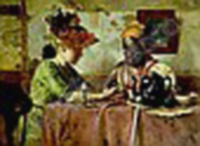
The Colored Palmist
(1903) (from a thumbnail-sized print; i have been unable to locate a larger copy;
Signed, titled, dated and inscribed "Painted to order for James G. Moulton, Chicago, ILL" on reverse,
oil on canvas. 11 x 15 in.)
Elements:
Red Tablecloth,
One Client

Palmistry
(Undated)
Elements:
Purse,
Bellows,
One Client,
Straw Hat,
Parasol,
Knitting Equipment in Hat Box,
Loose Yarn Balls,
Rocking Chair,
White Crocheted Shawl,
Arched Fireplace,
Rag Rug

Good Luck, Honey
(1906; Signed lower right: "(c) 1906 / Harry Roseland" and titled on verso; private collection)
Elements:
Bellows,
One Client,
Straw Hat,
Parasol,
Knitting Equipment in Hat Box,
Rocking Chair,
Arched Fireplace,
Rag Rug
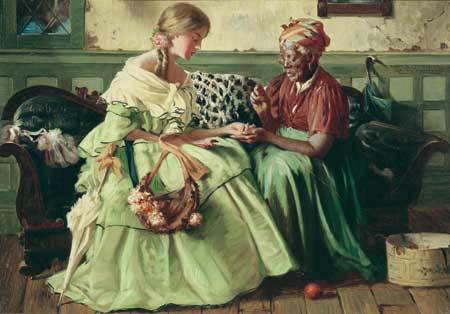
A Bright Future
(1906)
Elements:
Sofa,
Palmistry,
Hat Box,
Loose Ball of Yarn,
Braided Rug,
Purse,
Parasol,
No-Rug
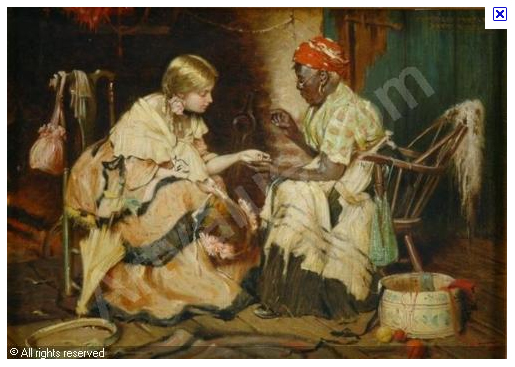
A Voodoo Palmist
(1907;inscribed and dated on the reverse: "A Voodoo Palmist" / copyright 1907 By / Harry Roseland"; Oil on canvas 10 x 14 inches)
Elements:
Chairs,
Palmistry,
Hat Box,
Loose Ball of yarn,
Braided Rug,
Purse,
Parasol

The Palmist (1909)
The Fortune Teller as Rootworker: Paintings by Harry Roseland

Mixing the Love Potion [Cropped]
(Undated; this image is a cropped version of the next picture)
Elements:
Kitchen, Two Clients, Iron Cauldron, Parasol, Hat Box, Kitten, Saucer, No-Rug, Arched Fireplace
In this painting we see the reader brewing something in a pot -- but it is not food in the
conventional sense and she is not a cook or Mammy. The title of the painting is "Mixing the Love Potion,"
and she is fulfilling the spiritual rootworker's role of preparing a magically active liquid or
potion which the client will add to the food or drink of the man she wants, to trick him into loving her.

Mixing the Love Potion [Jigsaw Puzzle]
(Undated; this image is an uncropped circa 1934 jigsaw puzzle version of the print)
Elements:
Kitchen, Two Clients, Iron Cauldron, Parasol, Hat Box, Kitten, Saucer, Rag Rug, Arched Fireplace
I have a copy of this as a framed full-sized print in my own collection, but i thought you would like to see
how popular Harry Roseland's prints were, and their widespread use in commerce. Here we see
"Mixing the Love Potion" used as the basis for a jigsaw puzzle! My grateful thanks to "Bob
Armstrong's Old Jigsaw Puzzles" web site at http://http://www.oldpuzzles.com for this image.
Bob has several Harry Roseland jigsaw puzzles in his collection. Here is what he says about this one:
"Love Potion; [puzzle made] ca. 1934; 750 pieces, 18" H x 23" W; brand: Macy's; artist: Harry Roseland.
Macy's puzzle sold through its department store in New York City in the 1930s. Plywood, interlocking,
cut along color lines with 66 figure pieces, very challenging. Most likely made by Parker Brothers
or Milton Bradley. Lovely curl knob cutting style displays well in this puzzle; scene appears
frequently in wood puzzles of the first half of the 20th century; a/k/a "Mixing the Love Potion."

The Love Potion
(Undated)
Elements:
Kitchen, One Client, Kitten, Prasol, Loose Ball of Yarn, Rag Rug, Arched Fireplace
In a setting similar to the above, the fortune teller prepares her love potion for one client.
|
